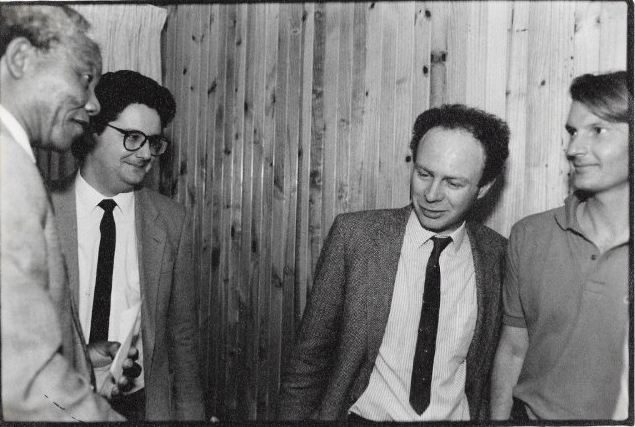
SA

The Weekly Mail ‘the most Jewish newspaper ever produced’
TALI FEINBERG
Titled Rhetorics of Resistance, the book, by Professor Bryan Trabold of Sussex University in Boston, explores the history of this anti-apartheid newspaper, which later became the Mail & Guardian.
“Most of the founders, both editors and managers, were Jewish. So were most of those who put money into it, so were the lawyers and the printers. The writers included Gus Silber, Arthur Goldstuck, Hilary Joffe, and Barbara Ludman; the illustrators included William Kentridge and Zapiro,” said Manoim.
While Rhetorics of Resistance is about censorship and resistance in the press during the late apartheid State of Emergency, the fact that the Weekly Mail was founded and produced mainly by Jews means that this is an important part of our community’s history, Manoim said.
Trabold based his book on two newspapers: The New Nation, a paper aimed at a largely black, working class audience and funded by the Catholic Church; and The Weekly Mail, “which was then largely owned by its own staff. Its aim was to open the eyes of white South Africans to what was happening in this country right under their noses,” said Manoim.
Trabold started his research 20 years ago in 1998, during a two-year period he spent in South Africa. He made several visits to South Africa after that, but nothing further materialised.
Manoim and Harber kept up a sporadic correspondence with Trabold over the years, when he would email questions to them. “It did come as a pleasant surprise when six weeks ago, he announced that the book had been published. He launched it in South Africa on 2 August at the University of Johannesburg,” said Manoim.
Trabold read every page of every edition of these two papers from 1985 to 1990, and also interviewed scores of people, trying to understand how people living in repressive societies respond to attempts to silence them.
“The reason he chose The Weekly Mail is that the paper was particularly cunning in its techniques of sliding around censorship. It used oblique language to tell forbidden stories by implication only, pushing the envelope and daring the authorities to risk taking it to court, and by manipulating loopholes in poorly-written regulations,” said Manoim.
“The paper was best known for its black lines and blank spaces, intended to draw attention to censorship – this was presumably successful because both devices were banned,” he said. “The book is a tribute not only to the journalists, but also to their creative lawyers. But, it is also a story about banning – The Weekly Mail was banned for several months – and intimidation and harassment.”
Staff were subjected to bricks thrown through windows, petrol bombs, court prosecutions, and detentions without trial.
Manoim believes the book is a valuable reminder of a forgotten period in South African history, “and in an age when the media are denigrated from all sides as ‘fake news’, it is a timely reminder that at the worst of times, a courageous press [and courageous printers] can be the best of antidotes”.
The entire launch team of The Weekly Mail was Jewish bar one, but Manoim believes there is nothing unusual about the number of Jews active in an anti-apartheid paper. “During the eighties, Jews were prominent in a number of anti-apartheid organisations such as the End Conscription Campaign, the Detainee Parents Support Committee, the Black Sash, and cultural organisations such as The Market,” he said.
“There were also many Jewish human rights lawyers active at the time, and several specifically Jewish anti-apartheid groups. But before we get too self-congratulatory, we should also remember that all whites benefitted from apartheid, that many Jews supported apartheid, and that those who spoke out came under frequent attack within the community for ‘fostering anti-Semitism’.”
Nowadays, it is unusual to see a Jewish name in a by-line, especially in the mainstream press. Manoim feels this is because in a period when South Africa’s population has doubled, the Jewish population has halved.
“This alone helps explain the fall-off in the number of Jewish journalists. Jews were prominent during a period when almost all journalists were white. The overall percentage of white journalists is also shrinking. Nonetheless, the small handful of Jewish journalists left are among the best in the country: Richard Poplak, Mandy Wiener, Kevin Bloom, and more.”
In an essay on the history of Jews and print newspapers in South Africa published in the Pesach 2018 edition of Jewish Affairs,” Manoim elaborates on this topic: “The Jews have left few footprints in the South African media. But they did take many of the first steps, played an important role as initiators of new media and as exposers of injustice, and this role deserves to be honoured.”
Now, more than ever, Manoim believes it is crucial that the Jewish community has a strong internal press. “There’s been a disturbing tendency within the Jewish community to silence internal dissent, and it is very important that a Jewish newspaper comes out emphatically on the side of free speech.
“The issue is not whether you agree with the dissenters, or who is right and who is wrong, but whether you come down on the side of open debate, or censorship. If there are any lessons to be learnt from The Weekly Mail, it is that there are times when an editor has to find the courage to make unpopular decisions.”




